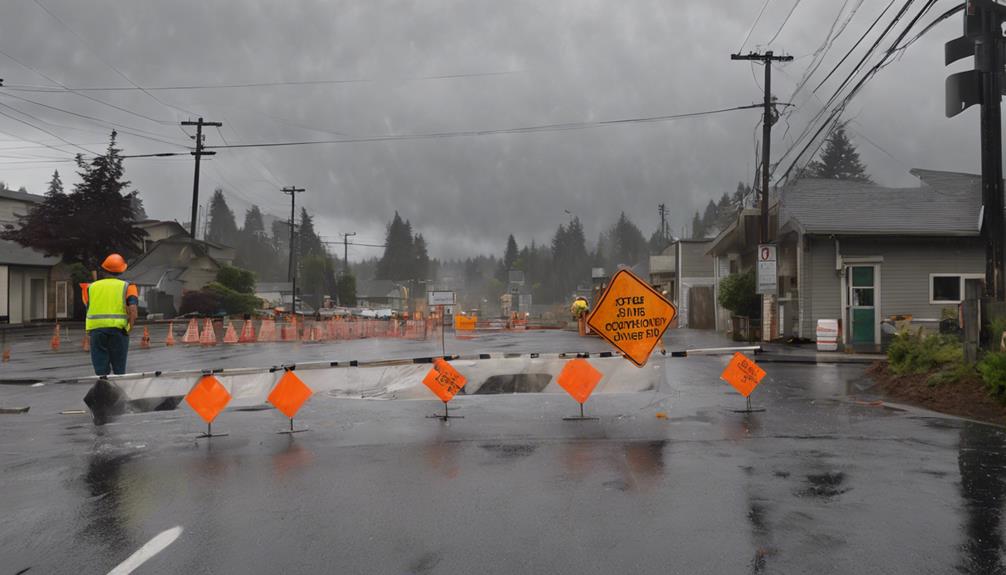If you're considering a construction project in Olympia, WA, understanding the Right of Way Bond is essential. This bond not only acts as a financial safety net for the community but also outlines your responsibilities as a contractor. Knowing how it impacts your project can save you from unexpected complications. So, what specific factors should you keep in mind when calculating the bond amount and navigating the application process? The implications might surprise you, and they could significantly influence your project's success.
Overview of Right of Way Bond

A Right of Way Bond is a financial guarantee that ensures compliance with regulations when a property owner or developer needs to use public land for construction or other purposes.
This bond protects the interests of local governments and the public by ensuring that any potential damages or disruptions caused by the construction are addressed.
When you apply for a Right of Way Bond, you're essentially promising that you'll adhere to the specific guidelines and requirements set forth by the governing body.
These might include restoring the land after your project is completed or minimizing the impact on traffic and surrounding properties.
The bond amount typically reflects the estimated costs of potential damages, ensuring you have the financial backing to cover any issues that arise.
If you fail to meet your obligations, the bond can be drawn upon to compensate for damages, which safeguards the community.
Understanding the requirements and securing the appropriate bond is crucial for your project's success.
It not only demonstrates your commitment to responsible development but also helps maintain a positive relationship with the local authorities and residents.
Importance of Right of Way Bond
Recognizing the importance of a Right of Way Bond can significantly impact your construction project's success. This bond acts as a financial assurance, ensuring that you'll comply with local regulations and compensate for any damages incurred while using public land for construction. By securing this bond, you're not only demonstrating your commitment to responsible construction practices but also protecting your investment.
Without a Right of Way Bond, you risk facing delays, fines, or even project shutdowns. Local authorities often require this bond before granting permits, so having it in place streamlines the approval process. It also builds trust with the community, showing that you're willing to uphold your responsibilities.
Moreover, should any disputes arise regarding your project's impact on the right of way, this bond provides a safety net. It covers costs associated with claims or damages, giving you peace of mind.
In short, a Right of Way Bond is essential for smooth project execution, regulatory compliance, and safeguarding your financial interests. Prioritizing this bond not only enhances your project's credibility but also ensures that you're prepared for any unexpected challenges.
Eligibility Requirements

Understanding the eligibility requirements for obtaining a Right of Way Bond is crucial for ensuring your project's success.
First, you need to be a licensed contractor or developer involved in a project that requires road or property access. You should hold the appropriate licenses and permits for your specific project type, as these are often mandated by local regulations.
Additionally, your financial standing plays a significant role; many bonding companies require proof of a solid financial history to assess your ability to manage the project and fulfill your obligations, especially when considering Illinois Surety Bonds for similar projects.
Next, it's essential to demonstrate a clean legal record, as any past violations or unresolved claims can affect your eligibility. Most bonding companies will conduct thorough background checks.
Moreover, you should be prepared to provide detailed project information, including timelines and budgets, to show that you have a well-thought-out plan in place.
Application Process
Navigating the application process for a Right of Way Bond can be straightforward if you prepare adequately. First, gather all necessary documentation, which typically includes proof of identity, project details, and any relevant permits.
You'll want to ensure that all your paperwork is accurate and complete to avoid delays.
Next, reach out to the appropriate local agency or authority in Olympia, WA, to obtain the specific application form. Most agencies have this form available online, making it easy to access and fill out.
Be sure to review the instructions carefully, as each agency may have unique requirements.
Once you've completed the form, submit it along with your supporting documents. Keep a copy of everything for your records.
Depending on the agency, you may also need to pay an application fee, so check that beforehand.
After submission, be prepared to wait for a response. Agencies often take time to review applications, so patience is key.
If you have any questions or concerns during the process, don't hesitate to reach out to the agency for clarification. Staying proactive will help ensure a smoother experience.
Bond Amount Calculation

Once you've submitted your application for a Right of Way Bond, the next step involves determining the bond amount you'll need. This amount typically reflects the potential costs associated with any damages or liabilities that could arise during your project.
To calculate it, you'll want to consider several factors. Understanding state regulations is crucial, as state-specific bonding requirements can significantly influence the bond amount needed.
First, assess the scope of your project. Larger projects generally require higher bond amounts due to increased risks.
Next, evaluate local regulations, as they can dictate minimum bond amounts based on specific criteria. Additionally, take into account the nature of the work you're undertaking. Projects that could disrupt public infrastructure or safety may also necessitate a larger bond.
It's also wise to consult with a bonding agent or insurance provider, as they can provide tailored guidance based on your unique situation. They often have experience navigating local requirements and can help you avoid pitfalls in the calculation process.
Responsibilities of Contractors
As a contractor, you hold significant responsibilities when working under a Right of Way Bond. Your primary duty is to ensure that all work completed within the right of way complies with local regulations and standards. This includes obtaining the necessary permits and adhering to any stipulations outlined by the city or county.
Additionally, it's important to consider the financial implications of your project and how securing performance bonds can protect both you and the project owner, as outlined in performance bond details.
You must also maintain clear communication with the relevant authorities. Keeping them informed about your project's progress and any potential issues is crucial. Regular inspections and documentation of your work will help demonstrate your compliance with the bond's requirements.
It's essential to protect public safety during your project. You're responsible for implementing effective traffic control measures and ensuring that your work zone is safe for both workers and the public.
Additionally, you must address any damage caused by your work to adjacent properties.
Lastly, you should be prepared to resolve any disputes that may arise with property owners or the city. This proactive approach won't only protect your bond but also help maintain a positive reputation in the community.
Consequences of Non-Compliance

Failing to comply with the stipulations of a Right of Way Bond can lead to serious repercussions for contractors. You might face financial penalties that can add up quickly, impacting your project's budget and cash flow.
Additionally, non-compliance can result in delays, as local authorities may halt your work until you rectify the situation. This not only affects your timeline but also your reputation in the industry.
Moreover, you could lose your bond, which serves as a financial guarantee for your obligations. Losing this bond means you'll need to secure a new one, often at a higher cost or with stricter qualifications.
Repeated non-compliance can also lead to a suspension or revocation of your contractor's license, limiting your ability to take on future projects.
Your clients may lose confidence in your ability to meet local regulations, which can damage your business relationships.
In the worst-case scenario, legal actions could arise from your failure to comply, resulting in additional legal fees and potential damages.
Staying compliant is crucial, not just for your current project but for your long-term success in the industry.
Resources for Further Information
Navigating the complexities of Right of Way Bonds can be daunting, but there are plenty of resources available to help you stay informed. Start with the Washington State Department of Transportation (WSDOT) website. They provide comprehensive guidelines and updates about Right of Way processes that are essential for understanding your obligations.
Local government offices in Olympia, such as the City Planning Department, offer valuable insights and may even have staff who can answer specific questions. Additionally, the Olympia City Council often holds meetings where you can learn about ongoing projects that might affect Right of Way issues.
Consider reaching out to industry professionals, such as land surveyors or real estate attorneys, who've firsthand experience with Right of Way Bonds. They can provide tailored advice based on your situation.
Don't overlook online forums and community groups focused on property development and land use; they can be excellent platforms for exchanging knowledge and experiences.
Lastly, keeping up with relevant blogs or publications can help you stay updated on trends and changes in legislation. With these resources, you'll be better equipped to navigate the Right of Way Bond landscape.
Conclusion
In summary, securing a Right of Way Bond in Olympia, WA, is essential for any contractor or developer working on public land. It not only protects the community but also ensures you meet local regulations. By understanding the eligibility requirements, application process, and bond calculation, you can navigate this responsibility smoothly. Remember, compliance is key—staying informed and proactive will help you avoid any consequences, allowing your project to proceed without a hitch.


